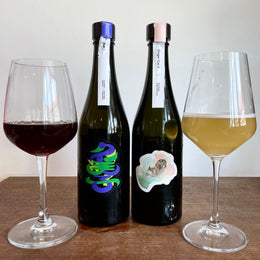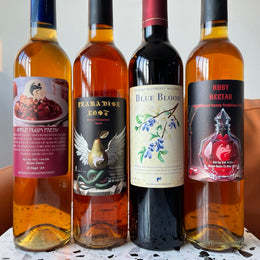
If you take a closer look at the Armagnac category, you’d learn that it is actually a spirit with 3 distinct regional styles: you've got the bold and earthy Bas-Armagnac, the balanced and fruity Ténarèze, and then there's the elegant and refined Haut-Armagnac. Now, Haut-Armagnac is like that sibling who's a bit of a recluse, producing way less than the other two, making it the rarest and generally the most expensive of the bunch. In contrast to the volumes produced by the Bas-Armagnac and Ténarèze regions, Haut-Armagnac accounts for a mere 1.6% of total Armagnac production. The disproportionate ratio is due to an unfortunate regional phylloxera crisis in the late 1800s which led to the mass uprooting of vineyards in Haut-Armagnac.

And that's where Château Arton steps into the spotlight. It stands as one of the few, and certainly the most prominent, producers in the exclusive terroir of Haut-Armagnac. Just how exclusive? While there are over 5000 hectares of vines planted across all three Armagnac regions, the Haut-Armagnac region only has a tiny 70-odd hectares of vines. Well over half of these 70 hectares of vines are all owned by the Arton estate. Today, it’s almost like Arton and Haut-Armagnac refer to the same thing.


Unlike many other Armagnac houses that source grapes from a patchwork of vineyards, Château Arton maintains an unwavering focus on its estate-grown fruit. This dedication to a single vineyard allows for an unparalleled expression of the terroir of the Haut-Armagnac region in every bottle. Haut-Armagnac’s terroir is shaped by the region’s distinctive white clay-limestone soils, which contribute to the unique mineral profile of the wines and spirits produced there. Additionally, the vineyards in Haut-Armagnac are often situated at higher elevations, with 220 meters being a typical elevation. This altitude can affect the climate and growing conditions, leading to slower grape ripening and the development of complex flavors.

Patrick de Montal, the founder of the estate, describes his philosophy succinctly: “We don’t produce Armagnac. We grow it.” These are grape cultivators inasmuch as they are spirit distillers.
Such dedication to craft and terroir has not gone unnoticed. In 2017, Château Arton was bestowed the prestigious Prix d'Excellence for Armagnac at the Concours Général Agricole. This accolade is reserved for the crème de la crème of brandy makers producers in France – not just for Armagnac. It is a testament to the vision of Patrick de Montal and his wife Victoire de Montesquiou who founded the estate together.

Patrick de Montal, Victoire de Montesquiou and the rest of the team at Château Arton.
Patrick found his start in the Armagnac industry not as a producer but a negociant. Eventually, he felt compelled to step into the industry himself to produce something of even better quality than was available. He acquired the estate with his wife in 1979 and worked to revitalize the vines. The approach to viticulture is a harmonious blend of tradition and modern practices rooted in sustainability. A minimal intervention policy is taken to allow nature to take its course and exhibit the terroir. They also employ permaculture and biodynamic practices to nurture the soil and promote the health of the vines, which grows a diverse array of nine grape varieties, including Ugni Blanc, Colombard, and Baco.

Beyond the vineyard, Château Arton is credited for pioneering the creation of France’s youngest AOC, the unaged Blanche Armagnac. A departure from the age-old barrel-matured style, this unaged Armagnac is intended to capture the essence of the eau-de-vie in its pure form. It wasn’t until the recent decades that Armagnac makers and indeed the global spirits community has begun to appreciate white Armagmacs. So, it is safe to say that Arton’s bold move to showcase Armagnac in its raw state at a time when the world was enamored with aged vintages, was nothing short of revolutionary.

As Patrick and Victoire now take a backseat in managing Château Arton, the baton is passed on to their son, Jean de Montal and his Chinese-Parisian partner Lili Chieng de Montal, who are tasked to write the next chapter of Château Arton.
I found myself at Syzygy recently where I had the opportunity to have a taste of the flagship Château Arton La Réserve Haut Armagnac. This is aged for at least 6 years in new oak and refill Gascon black oak casks, and is made with the Colombard and Ugni Blanc grape varieties.

While I have with me a rather traditional looking label of the La Reserve, I’m understand that the latest iteration of this expression comes a very attractive modern abstract design that seems to evoke the Bauhaus movement. It’s clear there’s a concerted effort to create a modern, elegant expression of Armagnac that could introduce this French spirit to a new generation of drinkers.
Let’s give this a taste.
Château Arton La Réserve, Haut Armagnac, 45% ABV – Review

Tasting Notes
Nose: Opens with a delightful perfumery whiff of sweet red fruits - think plums and raisins and dried aromatics in a luxurious potpourri. There's a subtle grassiness that brings a touch of freshness, followed by a faint minty herbaceousness reminiscent of Woods herbal cough syrup.
Palate: Thick and syrupy on the tongue, with a gentle warmth that builds alongside the sweetness. Sweetness and spice interplay beautifully with more notes of dried fruits and fruit cake, before a drier, distinctly European oak character takes centre stage. Orange oil adds a touch of zest, accompanied by a subtle chamomile bitterness offering a counterpoint.
Finish: Long and lingering, with a prominent aromatic oakiness that doesn't overwhelm, reminiscent of polished wooden cigar box. Notes of tobacco and oak intertwine with the light leather aroma of grandad’s well-worn leather armchair.

My Thoughts:
This is an expressive and well-crafted Haut Armagnac, beginning with the undeniably aromatic nose.
The palate is a tad straightforward, but I appreciate it for its accessibly fruity and oaky profile – it’s easy-to-understand and very friendly on the palate. If I had a bone to pick, the oak influence is perhaps a touch dominant - a slightly more luscious profile might have elevated it further. A slightly less oaky profile could potentially bring out more minerality.
Overall, a solid dram that shows great potential for the Haut-Armagnac category.
My Rating: 7/10
|
Score/Rating Scale :
|

@CharsiuCharlie







